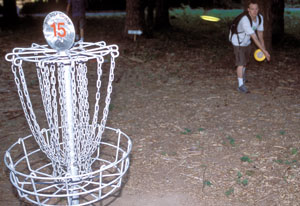Disc golf
Disc golf (also known as frisbee golf) is a sport in which the player tries to throw a small plastic disc into a metal basket in the least amount of throws possible. The rules of the game are similar to that of traditional golf, played with clubs and balls. Most of the disc golf courses in the United States of America are located in public parks and are free to play. According to the Professional Disc Golf Association (PDGA), disc golf is "designed to be enjoyed by people of all ages, male and female, regardless of economic status."[1]
History
The game of disc golf emerged after the invention of the Frisbee by "Steady" Ed Headrick in 1964. Early courses, called "object courses", began to pop up around the country using pre-existing objects such as lampposts, fire hydrants, and telephone poles as targets. The formalization of the game came when Headrick created the first Disc Pole Hole in 1975, which consisted of 10 chains hanging over an open basket. The first permanent course was installed in Oak Grove Park, Pasadena, California (U.S. state) the same year. Headrick also created the Professional Disc Golf Association in 1975, which he turned over control to the players in 1983, and it is the current governing body of the sport.[2]
The sport has experienced tremendous growth since its inception. In 1985, the World Flying Disc Federation helped internationalize the sport by holding the first World Championships outside of the United States in Helsinki, Sweden. In 2001, disc golf made it's debut at the World Games in Akita, Japan.[3]
Today, in the United States alone, there are over 2,000 courses.[4]
Gameplay and Rules
A round of disc golf is played in a similar manner to that of a round of "ball" golf. Each course will typically have 9 to 18 holes, with each hole containing a tee area, where you start, and a basket, where you finish. Each hole has a designated par value, which is typically 3 although some courses have started using 4 and 5. On a typical par 3 hole, the player will first throw, or drive, from the tee area into the fairway, followed by an approach shot, and finally a putt. As a player progresses through the course, they must remain behind where the disc has landed while throwing their next shot. The hole is finished when the disc comes to rest within the basket or the chains above it. The goal of the round is to finish the course with the fewest amount of shots possible.
Discs
The discs used in disc golf are designed to be smaller and heavier than the Frisbee that is often used to play catch with. The PDGA Technical Standards state that legal discs must be between 21 and 40 centimeters in diameter, weighing no more than 8.3 grams per centimeter with a maximum of 200 grams.[5]
Most discs will be in the 150 to 180 gram weight range, and between 21 and 22 centimeters in diameter.
Types of discs
There are three main styles of discs: drivers, midrange (or approach), and putters. Drivers are designed to fly the furthest, but are harder to maintain accuracy with. Midrange discs are designed to travel a shorter distance but are easier to maintain accuracy with. Putters are designed for close range, to fly straight and accurate, and able to easily catch in the chains of the basket.
One of the main traits of a disc is it's stability rating, or ability to fly straight when thrown. For a right handed thrower, an understable disc will turn to the right and an overstable disc will turn left. It is the opposite for left handed throwers. Each company that makes discs has a different rating system to denote the stability of their discs.
Discs are also made using different types of plastic, which effect cost, durability, and performance. Each company offers different styles of plastic.
Notes
- ↑ A Guide to Disc Golf from the PDGA. Retrieved on 2007-07-25.
- ↑ "Steady" Ed's Patents. Retrieved on 2007-07-25.
- ↑ The World Games flying disc sports. Retrieved on 2007-07-25.
- ↑ PDGA Online Disc Golf Course Directory. Retrieved on 2007-07-25.
- ↑ PDGA Technical Standards PDGA. Retrieved on 2007-07-25.
